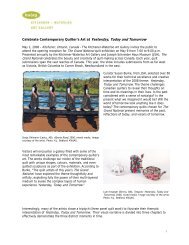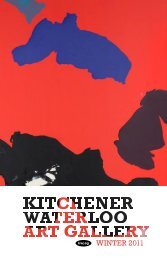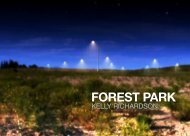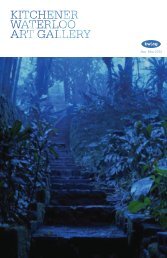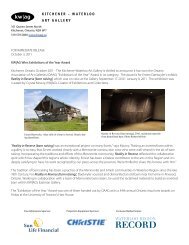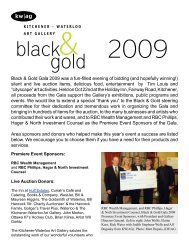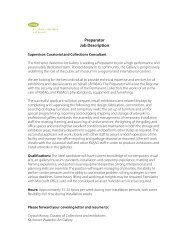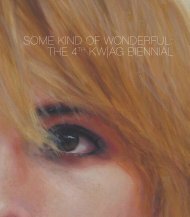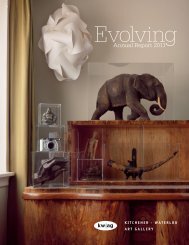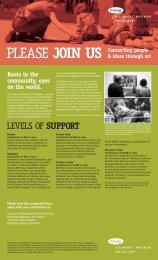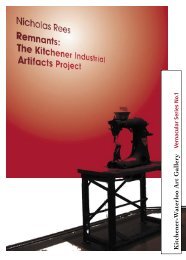Doug Kirton - Still Water and Rain - Kitchener-Waterloo Art Gallery
Doug Kirton - Still Water and Rain - Kitchener-Waterloo Art Gallery
Doug Kirton - Still Water and Rain - Kitchener-Waterloo Art Gallery
Create successful ePaper yourself
Turn your PDF publications into a flip-book with our unique Google optimized e-Paper software.
Double Cadillac Palace Theatre (Sketch), 2007<br />
oil on canvas, 28” x 22.25”
DOUG KIRTON<br />
WHEN ART HAPPENS: REFLECTION AND<br />
EXPERIENCE IN PAINTING<br />
// RICK NIXON<br />
<strong>Doug</strong> <strong>Kirton</strong>’s recent large paintings offer street level<br />
views of urban buildings, from Chicago specifically. In the main<br />
they capture a series of reflections <strong>and</strong> refracted views though<br />
windows on a rainy day, creating an ethereal array of surfaces <strong>and</strong><br />
transparencies, a place where reality is transformed into a visual<br />
puzzle. The accuracy of the perspectives <strong>and</strong> the depth of focus<br />
are proof that the images are sourced from photography. Pictures<br />
like this compel the viewer to find a position where the properties<br />
of vision enable us to decipher objects <strong>and</strong> surfaces in space. But<br />
the moment we suss out the complexity of the conundrum <strong>and</strong> fall<br />
into that place in front of the artwork where representation makes<br />
sense, <strong>Kirton</strong>’s painting gestures <strong>and</strong> effects disrupt the visual<br />
3
Intersection, 2007<br />
oil on canvas, 78” x 78”<br />
register of photography, shifting our position of access toward the<br />
realm of painting. Once this level of awareness is activated, our<br />
grasp of representational space loosens, <strong>and</strong> <strong>Kirton</strong>’s programmethe<br />
teasing out of abstract gestures from the substructure<br />
of photography’s apparent reality- hits us like a discovery.<br />
Discovery is a hard won accomplishment in the business<br />
of serious painting, but <strong>Kirton</strong>’s ideas arise from a deep curiosity<br />
about the metaphoric <strong>and</strong> psychic possibilities regarding reflection<br />
<strong>and</strong> visual perception. Ours is a time when perception is once again<br />
4
open to change. Technologies, such as the digital photography<br />
that <strong>Kirton</strong> uses to approximate his final paintings, have created<br />
the possibility of images that were unimaginable until recently.<br />
Between the camera <strong>and</strong> the studio, he selects the images that<br />
exhibit a kind of art historical awareness: what starts out as<br />
a passive scroll through an image cache produces associations<br />
with other paintings he has seen <strong>and</strong> probably admired. These<br />
associations are mainly abstract painting gestures. It is a<br />
tricky point in the development of his work since <strong>Kirton</strong> has to<br />
acknowledge that his affinity with the paradigmatic culture of<br />
painting is inflected with his subjectivity. His main project is to<br />
translate the increments of perception into legible matter. It is<br />
important that his selection process places value on recognition<br />
<strong>and</strong> acceptance of art history’s st<strong>and</strong>ard without overwhelming<br />
the viewer or himself with a slavish reference to other painters.<br />
Therefore, he translates his observations with sensitivity <strong>and</strong><br />
nuance, a generous form of ambivalence that offers the viewer<br />
an object lesson about the range of possibility between optical<br />
<strong>and</strong> tactile underst<strong>and</strong>ing.<br />
Once in the studio, he establishes a satisfying uncertainty<br />
regarding the elision between representation <strong>and</strong> abstraction<br />
(annexed with his huge catalogue of painting effects <strong>and</strong> marks).<br />
In the final stages he adds the subtlest forms of colour modulation<br />
5
6<br />
Double Cadillac Palace Theatre, 2007<br />
oil on canvas, 106.5” x 84”
as a counterpoint to his intensified highlights by placing slightly<br />
different hues of grey side by side in some of the peripheral<br />
zones. In a painting like Double Cadillac Palace Theatre (Large<br />
Version), 2007, the viewer is met with the trompe-l’oeil effect of<br />
flat areas pushing <strong>and</strong> pulling on the edges of the visual plane.<br />
This optical modulation, a technique that is arguably unreliable in<br />
any other medium, seems to reinforce the primacy of painting as<br />
the only discipline capable of clarifying <strong>and</strong> unpacking perceptual<br />
underst<strong>and</strong>ing in the world of images.<br />
I do not think <strong>Kirton</strong> would be comfortable authorizing<br />
any particular discipline, however. Painting is a natural means of<br />
discovering the world for him, <strong>and</strong> a durable research tool, but<br />
ultimately as much a technological prosthesis as photography. In<br />
addition, in order for the experience of perception to be grasped,<br />
<strong>and</strong> then understood, the pre-cognition of culturally inflected<br />
visuality needs to be shed, an impossible limitation given the<br />
prescriptive forces governing recognition; which is why <strong>Kirton</strong><br />
deploys painting in the manner of revision, undoing the pretence of<br />
the factual content of the photograph, <strong>and</strong> in the process, troubling<br />
the certainty of documentary, media, <strong>and</strong> cultural consciousness.<br />
The ostensible ideologies that speak the fiction of truth telling<br />
methods are also brought into question. <strong>Kirton</strong>, who started with<br />
the gloss of reflection <strong>and</strong> refraction as a purely visual exercise,<br />
7
EXHIBITION INSTALLATION
EXHIBITION INSTALLATION
12<br />
The Cadillac Palace Theatre in the <strong>Rain</strong>, 2007<br />
OIL on canvas, 106.5” x 84”
has altered the discourse on visuality to exceed its gravity, <strong>and</strong><br />
to think in the metaphoric, contemplative senses of reflection. In<br />
this way, he favours contemplative closeness over critical distance.<br />
In fact, it seemed to <strong>Kirton</strong> that painting settled into<br />
a polite series of polemics during the thirty years that he has<br />
been working. As an artist <strong>and</strong> art professor, he is intimate<br />
with, <strong>and</strong> his work has been professionally subjected to, many<br />
of the debates regarding the discipline’s official discourses. For<br />
example, earlier works like the The Suburban House Series or The<br />
Toxic Pool Group each signified the wasted surpluses supplied by<br />
consumerist failures (signalled by the alienation of suburban life)<br />
<strong>and</strong> polluted l<strong>and</strong>scapes (yielding both the romantic pleasure of<br />
ruins <strong>and</strong> the critique of teleologies). His new paintings, such<br />
as The Cadillac Palace Theatre (Large Version), 2007, apparently<br />
demonstrate similar traits regarding the discourse on excess:<br />
sources are overtly urban; the visual dazzle of the consumerist<br />
spaces echo the media-saturated consciousness of the viewer;<br />
<strong>and</strong> <strong>Kirton</strong>’s specific gaze is trained on the seductive surface<br />
of reflections supplied by store-front glass <strong>and</strong> rain-wetted<br />
streets. Yet <strong>Kirton</strong>’s transparency about his method credits the<br />
viewer with the ability to follow his dialectic. There is a smooth<br />
<strong>and</strong> legible transition between visual registers that naturalizes<br />
the shift, <strong>and</strong> brings into question the authority of signifying<br />
13
14<br />
Two Prudential Plaza: Clearing Storm, 2007<br />
Oil on canvas, 78” x 78”
systems, the art historical project included. When he makes the<br />
tipping point between categories indistinct, he is suggesting that<br />
the external agents qualifying art have difficulties pinpointing<br />
when something is art. Put another way, the signifying structures<br />
of art are external to his role as prime generator of conditional<br />
conversions <strong>and</strong> alterations. No wonder that <strong>Kirton</strong> refers to<br />
framing, whether through an actual or an art historical lens, as<br />
“waiting for something to happen”. Perception actually happens:<br />
it is the material of experience. And experience is an index of self.<br />
Rick Nixon is an artist <strong>and</strong> writer living in <strong>Water</strong>loo working in the Fine <strong>Art</strong>s<br />
Department at the University of <strong>Water</strong>loo. He has a Masters in <strong>Art</strong> History from<br />
York University <strong>and</strong> a Master of Fine <strong>Art</strong>s from the University of <strong>Water</strong>loo. He<br />
has worked as a curator in various galleries in Southwestern Ontario.<br />
15
Early Spring <strong>Water</strong>s, 2007<br />
oil on canvas, 28” x 28”
<strong>Art</strong>ist Statement<br />
“The object of reflection is invariably the discovery of something satisfying to<br />
the mind which was not there at the beginning of the search”. Ernest Dimnet<br />
The paintings in this exhibition were inspired by the abstracted images I saw<br />
reflected in the windows of rainy city streets <strong>and</strong> in bodies of water. I’m<br />
fascinated by the ways in which reflections suggest an ethereal virtual world<br />
where unexpected <strong>and</strong> exaggerated collisions of colour <strong>and</strong> shape momentarily<br />
transform the world, providing seemingly endless painterly possibilities. My job<br />
then, is to “pin down” these uncanny scenes in paint.<br />
For convenience <strong>and</strong> immediacy I capture the compelling moment with a camera<br />
<strong>and</strong> work from selected pictures later. While the photographs usually provide a<br />
good approximation of what the finished painting will look like, they are never<br />
perfect - I try for that in the studio, where interpretation <strong>and</strong> invention go<br />
into the composition <strong>and</strong> process of painting. I often use digital image editing<br />
software to visualize effects that I may not have considered otherwise - similar<br />
to how a writer might use a thesaurus to suggest more colourful wording.<br />
One synonym of reflection is contemplation. Similarly, painting for me is a<br />
form of contemplation. My work starts with the perception of things seen <strong>and</strong><br />
sensations felt. Proceeding in the studio allows me to internalize <strong>and</strong> clarify<br />
all of this information in a personal way <strong>and</strong> in doing so I hope to convey the<br />
complexity of my experience. Above all, painting is my research tool; the way<br />
I discover the world <strong>and</strong> my place in it.<br />
<strong>Doug</strong> <strong>Kirton</strong><br />
<strong>Kitchener</strong>, 2007
Cover: Intersection, 2007, oil on canvas, 78” x 78”.<br />
Inside cover: The Cadillac Palace Theatre in the <strong>Rain</strong> (Sketch), 2006, oil on canvas,<br />
32” x 24”. Private Collection.<br />
Exhibition installation photography: K.J. Bedford.<br />
Images courtesy of the artist <strong>and</strong> KW|AG.<br />
September 14, 2007 - January 6, 2008<br />
<strong>Still</strong> <strong>Water</strong> <strong>and</strong> <strong>Rain</strong> was organized by the <strong>Kitchener</strong>-<strong>Water</strong>loo <strong>Art</strong> <strong>Gallery</strong>.<br />
ISBN 978-0-9782669-7-4<br />
Copyright © 2007 <strong>Kitchener</strong>-<strong>Water</strong>loo <strong>Art</strong> <strong>Gallery</strong>, <strong>Doug</strong> <strong>Kirton</strong>, <strong>and</strong> Rick Nixon.<br />
Design: C. Mowry<br />
<strong>Kitchener</strong>-<strong>Water</strong>loo <strong>Art</strong> <strong>Gallery</strong><br />
101 Queen St. North | <strong>Kitchener</strong>, Ontario<br />
N2H 6P7 | CANADA | 519.579.5860<br />
www.kwag.on.ca



